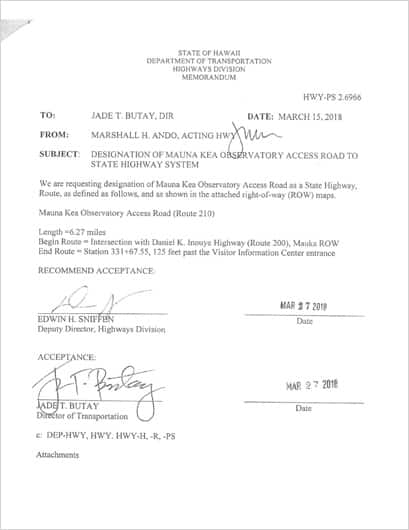Does the Department of Transportation have jurisdiction over Mauna Kea Access Road?
(Revised 12.22.19)
Without ownership of Mauna Kea Access Road (MKAR), how can the DOT claim that MKAR is part of the State Highway System over which it has jurisdiction?
State assertions
In an August 30, 2019 joint statement, the Department of Transportation (DOT), the Department of Hawaiian Home Lands (DHHL), and the Department of the Attorney General, proclaimed that the DOT has jurisdiction over the Mauna Kea Access Road (MKAR). To support their claim, they cited that (1) the DOT has control and jurisdiction over all state highways, following Hawaiʻi Revised Statutes (HRS) §26-19 and §264, and that (2) the MKAR had been designated a state highway.
HRS §26-19 indeed gives the DOT the authority to engage in planning, building, and managing a State Highway System. And HRS §264-42 gives DOT the authority to “designate for inclusion in the state highway system, such other public highways, including county highways.”
However, in any transfer where DOT accepts a highway into its system, there must be a paired process where the entity that owns the road completes its processes to transfer that asset to the DOT.
State’s failure to meet conditions
Such a process had been outlined to address a total of 346.233 acres of DHHL lands unilaterally used by the DOT for various highways and roads, 65.142 acres of which comprise MKAR. A proposed set of conditions was presented to and accepted by the Hawaiian Homes Commission (HHC) in 1994, as seen in the HHC’s November 4, 1994 meeting minutes, which outlined the specific highways and roads involved along with the respective acreage of each. A specific condition for the transfer was that the DOT “apply the sale proceeds of the Marks Estate property in a planned auction, estimated in excess of $5 million, to purchase lands on Oahu of HHL’s own choice, for a land exchange with HHL to acquire the roads and highways.”
Significantly, the actions that the HHC had approved were contingent upon the State providing the agreed to compensation. And “in the event of non-compliance…then the HHC through its DHHL reserve[d] the right to hold off any release of its claims as to that particular proposal, based on any such non-compliance by the State of Hawaii.”
No land transfer
Although the State has had a quarter century to provide DHHL the compensation to seal the transfer, it has failed to do so, triggering the non-compliance and solidifying DHHL’s continued ownership of the 346.233 acres, lands the State has been using freely for decades for public highways and roads with no compensation to DHHL beneficiaries.
The DOT cannot unilaterally claim highways and roadways that are DHHL trust lands because those trust lands are set apart from other state owned land. The Hawaiian Homes Commission Act (HHCA Section 206) states that “the powers and duties of the governor and the board of land and natural resources, in respect to lands of the State, shall not extend to lands having the status of Hawaiian home lands, except as specifically provided in this title.” As with the governor and the Board of Land and Natural Resources, the DOT is not authorized in the HHCA to take lands from the DHHL trust. DHHL lands are not part of the general pool of government lands but are reserved exclusively for DHHL’s trust purpose.
Still, even without legal authority, the DOT attempted to incorporate the DHHL-owned Mauna Kea Access Road (MKAR) into its DOT State Highway System using a March 15, 2018 internal DOT memo. This memo originated in one part of the DOT and sought approval from higher DOT officials to add MKAR into its State Highway System, absent consent from the land owner, the DHHL.
No ownership, no jurisdiction
A key failing of the March 15, 2018 internal DOT memo and the State’s August 30 inter-department joint statement is their inattention to HRS §264-2, which requires that “the ownership of all public highways and the land, real estate and property of the same shall be in the government in fee simple” (emphasis added). Without land ownership, the DOT cannot claim a highway to be within its State Highway System.
It has been argued convincingly, and admitted to in a Senate briefing held by Senators Maile Shimabukuro and Kaiali‘i Kahele that the DHHL did not properly transfer MKAR to the DOT. Governor Ige also acknowledged DHHL’s ownership of MKAR in his December 19, 2019 press conference.
Without ownership of the Mauna Kea Access Road, how can the DOT claim it has jurisdiction over it? And if the DOT does not have jurisdiction over the Mauna Kea Access Road, how can it call for law enforcement to clear the road?

